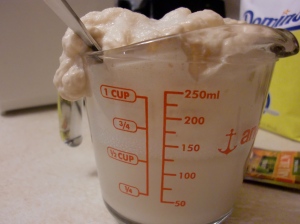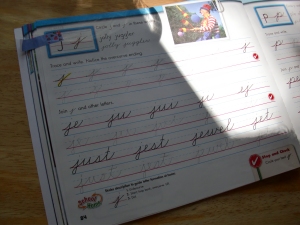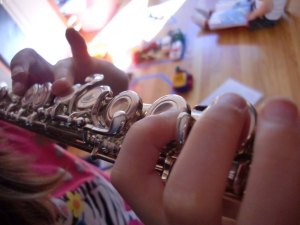In Part I, I gave an overview of our homeschooling lives. In this post, I provide information about the materials we use and how we chose them. Not every homeschooling family uses materials of this type, this is just what we use (for now).
When it comes to curriculum and how child-led I want my children’s education to be, I’m influenced by both The Well-Trained Mind (which I’ll abbreviate as TWTM) and Thomas Jefferson Education (see A Thomas Jefferson Education: Teaching a Generation of Leaders for the Twenty-First Century by Oliver DeMille), both of which encourage families to use different approaches to suit their child’s age, development, interests, and temperament.
What seems to be working for us at this point is for me to set up a list of subjects that it’s important to me that my daughter cover, and then let my daughter help me in deciding what to study when and—albeit to a lesser extent—which materials to use. I try to let her be part of my decision-making process so that as she gets older, she’s prepared to take on more responsibility for designing her own education.
My daughter’s big on structure and loves to work through things in order from start to finish, so our materials are fairly traditional (texts, workbooks, etc) and we tend to follow a fairly set routine. We try to allow plenty of time for open-ended exploration in addition to the more structured instruction, and following a routine helps facilitate this.
What follows is a list of the subjects we study, the materials we use, and a few notes about how we chose them. Many of the materials that have worked for us are those recommended in TWTM, but we’ve made several modifications in response to my daughter’s needs and interests.
For the nearly 8-year-old:
Math:
Saxon Math homeschool curriculum, supplemented with Life of Fred by Stanley F. Schmidt. I used Saxon Math in my eighth-grade algebra class, and I remembered how effective it was in helping me to retain concepts, so I went with Saxon first. It turned out to be a good fit for our daughter, so we’ve stuck with it. The only trouble we’ve had is that it seems to assume that children are taking off for a three-month summer break during which they’re doing no math at all. As a result, there’s a lot of review at the beginning of each level. We customize the program to some extent to prevent my daughter from becoming bored with excessive review. We do Saxon four days a week and Life of Fred on the fifth. Life of Fred is math concepts taught through the story of Fred Gauss, a five-year-old math professor at KITTENS University in Kansas. The books are silly and fun and do a great job of linking concepts from math and other disciplines (history, economics, biology, etc). My daughter loves doing Life of Fred; she considers it a treat, and we do it on our instruction-light weekly Library Day.
Science:

Adventures with Atoms and Molecules, Books 1 and 2, by Robert Mebane and Thomas Rybolt, and The Usborne Science Encyclopedia (which includes links to fun, relevant activities online). This year we’re doing 30 weeks of chemistry. My daughter’s only seven, so we’re not breaking out my spouse’s organic chemistry books yet or anything, but we’re doing some fun basic chemistry experiments. We do two experiments from Adventures with Atoms and Molecules each week, including completing an experiment page for each and adding to our definitions page. This follows the recommendations from TWTM pretty closely. The experiments are easy to follow and mostly don’t involve any wacky items. The toughest ones for us were those that called for 16-ounce bottles of cola. We never buy soda, and we had to make a special trip to Target to get a couple of bottles.
Writing:
Writing with Ease by Susan Wise Bauer (leveled instruction books including student pages). There are four lessons each week. For the level my daughter’s in now, there are readings from classics of children’s literature and dictation assignments based on those selections (earlier levels had copywork rather than dictation). We love the readings that are included. They have introduced us to so many fantastic children’s books that we might not have found otherwise. Many of our read-alouds and the books my daughter reads to herself come from the reading excerpts in this curriculum. My son enjoys listening in on these stories, too.
Grammar:
First Language Lessons for the Well-Trained Mind by Jessie Wise. The level my daughter is in this year has both a workbook and an instructor’s guide; up to now it’s just been one book. In this level, my daughter has started diagramming sentences. She loves diagramming sentences (in case there was any doubt that she’s my offspring).
History:
The Story of the World by Susan Wise Bauer (text and workbook) and The Usborne Encyclopedia of World History (internet-linked like the science encyclopedia). We’re in volume 2, which covers the Middle Ages. It’s a pretty rough overview, but I’ve been very impressed at just how much of world history this curriculum covers. We do a new history lesson/chapter each week and read books and do activities from that lesson throughout the week (the student workbook includes history and literature suggestions, and we pick up some of those from the library, and read from them at breakfast and after lunch most days throughout the week). Some families use the audio recordings of the books read by Jim Weiss. I thought about getting those because my kids love Jim Weiss, but so far, they seem perfectly happy to have me read to them and to read to themselves. My daughter reads the texts for fun in her free time. (She also reads books on child development, and she’s been telling me all of these things she’s supposed to be doing starting at age eight when she’s officially (according to this book) a “pre-teen.” I fear sometimes she sees these child development books as prescriptive rather than descriptive.)
Spelling:
Spelling Workout from Modern Curriculum Press (I buy only the student books). This was recommended in TWTM and is basically a workbook. It’s the first we’ve tried, and my daughter loves it. We do spelling twice a week. When she gets a little older, I’m going to add (or perhaps replace this with) a vocabulary lesson. I’m eyeballing the Vocabulary from Classical Roots series since my daughter loves ancient languages so much (and since it’s gotten good reviews online). Wordly Wise is another that’s rated highly, but that looks like it might overlap a bit with the writing and grammar we’re already doing. I’ll preview and make a decision by next fall, I expect.
Handwriting:
 Zaner-Bloser handwriting workbooks because I like that script best (I do not buy the teacher’s editions, just the student books and a ream of handwriting paper for the grade level she’s in). My daughter does a page or two from the workbook twice a week, and writes letters and cards to family and friends for extra practice. This is another subject she loves.
Zaner-Bloser handwriting workbooks because I like that script best (I do not buy the teacher’s editions, just the student books and a ream of handwriting paper for the grade level she’s in). My daughter does a page or two from the workbook twice a week, and writes letters and cards to family and friends for extra practice. This is another subject she loves.
Flute:

This is our most time-consuming subject. Each day we practice for 45-60 minutes. My daughter has a private lesson each week and a group class each week or two. This coming fall, we plan to add another ensemble to that mix. What that will be, we’re not quite sure yet, I just hope it doesn’t involve another 45-minute commute like her lessons and group classes do. We follow the Suzuki Method, which has been wonderful for my daughter and for me. We find that it fosters joy, cooperation, and a love of music while helping children become confident in their ability to set and meet challenges. We also have a phenomenal teacher (one whom we spend a lot of time in the car to see each week).
Latin:
 This is new this year. We started out with a Latin curriculum recommended in TWTM (Prima Latina), but when that one wasn’t working, we switched to Lingua Latina per se Illustrata by Hans H. Ørberg. I chose this one because it’s the text used in the Latin classes I decided we’d sign up for if it turned out I couldn’t learn Latin alongside my daughter. So far, we’re both loving it. It teaches Latin through the story of a family in ancient Rome. There are no vocabulary lists to memorize and direct translation is discouraged. The meaning of words is picked up through context. My daughter is very proud of all that she’s learning and uses Latin when she can throughout the day. It’s interesting to watch my daughter get frustrated almost to the point of tears only to switch over to elation and celebration in the next instant when the lightbulb goes off. We do a lesson a week, and we do Latin four or five days a week. We got the companion CD-ROM for Mac, which includes tests and exercises (which are a little buggy and sometimes frustrating to use), and Ørberg reading the text in Latin, which is what we really love about it. The reading bit is a bit buggy, too (for example, you can’t pause the reading. If you stop it, you have to listen back through the whole chapter to get to where you were), but Ørberg is such a pleasure to listen to, it doesn’t bother us much.
This is new this year. We started out with a Latin curriculum recommended in TWTM (Prima Latina), but when that one wasn’t working, we switched to Lingua Latina per se Illustrata by Hans H. Ørberg. I chose this one because it’s the text used in the Latin classes I decided we’d sign up for if it turned out I couldn’t learn Latin alongside my daughter. So far, we’re both loving it. It teaches Latin through the story of a family in ancient Rome. There are no vocabulary lists to memorize and direct translation is discouraged. The meaning of words is picked up through context. My daughter is very proud of all that she’s learning and uses Latin when she can throughout the day. It’s interesting to watch my daughter get frustrated almost to the point of tears only to switch over to elation and celebration in the next instant when the lightbulb goes off. We do a lesson a week, and we do Latin four or five days a week. We got the companion CD-ROM for Mac, which includes tests and exercises (which are a little buggy and sometimes frustrating to use), and Ørberg reading the text in Latin, which is what we really love about it. The reading bit is a bit buggy, too (for example, you can’t pause the reading. If you stop it, you have to listen back through the whole chapter to get to where you were), but Ørberg is such a pleasure to listen to, it doesn’t bother us much.

Thanks, I’m going to look into Life of Fred as a supplement!
LikeLike
Love the curriculum you use with your daughter. It is almost exactly what we have used, with the exception of Life of Fred. I’m getting pretty curious about this…
LikeLike
Curious about Life of Fred? Well, like I said, my daughter finds it very fun. I know people who use it as their entire math curriculum, but I’m not quite comfortable with that. It moves kind of quickly through new concepts, and while too much repetition can lead to boredom, I think the “right” amount that helps to reinforce what’s been introduced. I do love how it relates math to other studies (physics, chemistry, art, spelling, biology, history, literature). I think it is a great supplement to Saxon because it gets my daughter thinking about math from a different direction. And I enjoy reading the stories, too. 🙂
There is occasional mention of morals from a Christian perspective, but it’s not overbearing or preachy or even religious in a passing-of-doctrine sense (at least not to my eye). The author just kind of touches on morals, like when Fred’s the victim of an unscrupulous salesperson or when his money is stolen. Fred’s trusting and compassionate in the face of these betrayals even as he learns lessons about being more cautious, and I kind of like that.
Thanks for stopping by! I love comments anyway, but even better, your comment led me to your blog, which I’m quite enjoying!
LikeLike